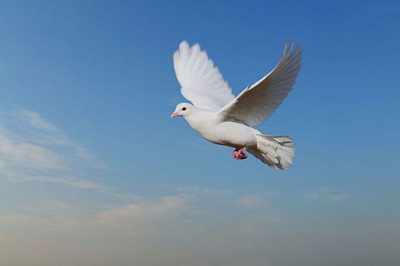(单词翻译:单击)
听力文本
This is Scientific American — 60-Second Science. I'm Jason Goldman.
Pigeons. Ever since humans established permanent agricultural settlements, we've lived side-by-side with the birds—or, as some people call them, rats with wings. They walk on our sidewalks, roost on our buildings, and eat our leftovers. But soon pigeons may help us identify risks to public health.
"What we're doing here in my lab is we're assessing how we can use something that's been considered a pest that people actively try to exterminate: the pigeon. How can we use it to better the environment for not only ourselves but for pigeons and for other wildlife?"
U.C. Davis neurobiologist Rebecca Calisi. She looked at lead levels in blood samples from more than 800 injured pigeons brought to a New York City wildlife rehabilitation center. And she compared those to lead levels in blood samples collected from children by the New York City Department of Health in routine screening efforts. The results were published in the journal Chemosphere.

"The neighborhoods where children have high rates of lead toxicity, that's where we saw pigeons with high blood lead levels...so this is a proof of concept kind of project."
Most pigeons will live out their lives within just two kilometers of the place they hatched, so the birds may be able to help researchers develop a detailed map of the risk of toxic lead exposure.
In people, especially kids, lead exposure can affect intelligence, brain development, social skills and memory. Having demonstrated that pigeons can pinpoint areas with high lead contamination, Calisi thinks that the birds can help researchers zero in on other potential environmental hazards as well.
"The thing is, we don't know what to test for right now. We know to test for lead, but what about certain pesticides? Or fire retardants are a big problem these days. We're not sure what the problems are. So instead of drawing a ton of blood from children and putting them through all these tests, why not use an animal that shares our environment, the pigeon, and test for a whole suite of different potential harmful pollutants?"
So rather than dismissing them as rats with wings, why not think of them as...lab rats with wings?
Thanks for listening for Scientific American — 60-Second Science Science. I'm Jason Goldman.
参考译文
这里是科学美国人——60秒科学。我是杰森·古德曼。
鸽子。自从人类建立永久性农业定居点以来,鸽子就一直与我们生活在一起,甚至有一些人称鸽子是有翅膀的老鼠。鸽子走在人行道上,栖息在建筑楼顶,吃我们的剩饭剩菜。但是不久以后鸽子可能会帮助我们确定公共卫生风险。
“我们正在实验室里评估如何使用被人们认为是害虫且一直想要消灭的动物:鸽子。我们怎么用鸽子更好地保护环境,不仅对我们人类有利,同时也对鸽子和其他野生动物有利?”
丽贝卡·卡利斯是加州大学戴维斯分校的神经生物学家。她对纽约市野生动物康复中心800多只受伤鸽子血液样本中的铅含量进行了研究。并将这些同从纽约市卫生局常规检查中收集来的儿童血液样本中的铅含量进行了比较。结果发表在《Chemosphere》杂志上。
“社区儿童高铅毒性的地方,也就是我们看到鸽子高血铅水平的地方……这是项目所证实的概念。”
大多数鸽子生活在距离它们的出生地只有2公里的地方,所以这种鸟类也许可以帮助研究人员绘制详细的铅毒风险地图。
对人们来说,尤其是对孩子来说,铅暴露会影响智力、大脑发育、社会技能和记忆力。卡利斯已经证明鸽子可以确定高铅污染的地区,她认为鸟类也可以帮助研究人员发现其他潜在的环境危害。
“问题是,目前我们不知道要怎么检测。我们知道要检测铅,但特定的农药呢?也许现在阻燃剂也是一个大问题。但是我们不确定是什么问题。所以我们没有没有提取孩子的大量血液样本进行测试,而是用动物血液,也就是鸽子的血液来测试各种潜在有害污染物。”
因此,与其蔑视它们是长着翅膀的老鼠,为什么不把它们看作是有翅膀的实验鼠。
谢谢大家收听科学美国人——60秒科学。我是杰森·古德曼。
译文为可可英语翻译,未经授权请勿转载!
重点讲解
重点讲解:
1. ever since 自从;打…以后一直;
例句:She leave school three year ago and have work as a nurse ever since.
她三年前毕业,从那时起便一直当护士。
2. live out (在某处或某种境况下)度过余生;
例句:Gein did not stand trial but lived out his days in a mental asylum.
盖因没有受审,但在一家精神病院度过了余生。
3. zero in on 全神贯注于(问题或主题);
例句:They zeroed in on the suspicious man.
他们的注意力集中在那个可疑分子身上。
4. instead of 代替…;而不是…;
例句:Instead of pressing forward, they drew back.
他们不仅没有前进,反而后退了。
5. rather than 而非;胜于;而不是;
例句:Rather than risk a bad crossing, he postponed his journey.
他推迟了旅行的时间,不愿冒着风浪横渡。


